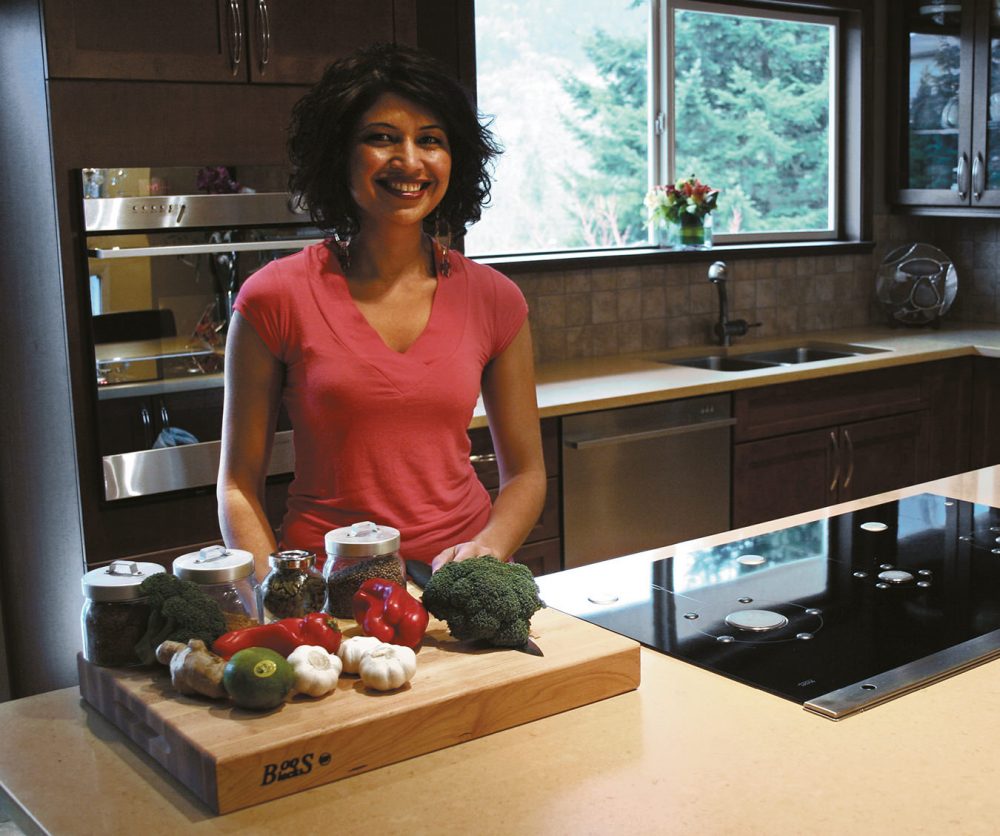Bal Arneson grew up in a small village in India. As a child, she was admonished that she needed to be a good cook; it would pay dividends when she was an adult woman, she was told. Although it is not quite the context that her elders likely imagined, Arneson has indeed turned her hard-earned cooking knowledge into significant dividends. She is a television host, a contributor to The National Post, the author of a runaway best-selling cookbook, and the star of her soon-to-be-launched show on the Food Network in the U.S.
Arneson’s personal story includes an arranged marriage; her resolve to leave that marriage, resulting in single motherhood; the will to earn both a living and an education; the fortune of being discovered and mentored by a producer at Citytv, and shortly thereafter by Robert McCulloch, publisher of Whitecap Books; and finally, a happy second marriage, another child, and, of course, a career as culinary star.
As stories go, hers is both colourful and dramatic, but these days Arneson seems remarkably free of the burdens she once bore. As she cooks a few dishes in her new designer kitchen—built with the filming of her cooking shows in mind—she provides a running commentary, not only about what and how she is cooking, but about the underlining reasons for her success. “I was determined, as a little girl, to really learn the spices, how to roll the roti, how to keep things as simple and fresh as possible.” She pauses, smiles, and adds, “It was the toughest cooking school on earth, as far as I was concerned. If I failed to roll the roti just so, I would get a slap on the hands. You learned to do it the exactly correct way. And in my village, every meal was wonderful. This is what I try to bring to people here in Canada.”
“For me, it is always about making delicious meals, quickly and easily.”
Food from Arneson’s native India is widely variegated, differing from region to region, even village to village. Certain spices and herbs—cardamom, say, or fennel, cumin, paprika, and the list goes on—are in play almost everywhere. But the key is in how they are used, and in what proportions. The amalgam of spices we all know as curry is different throughout India. “There is no one single curry recipe,” Arneson says.
Still, this potentially bewildering array of possibilities becomes completely approachable in her capable hands. “For me, it is always about making delicious meals, quickly and easily.” And she is not kidding; it is at the root of her charm and allure to an ever-widening audience base. Today there is a yam soup, bursting with fresh flavour, but the definition of simplicity: yams peeled, chopped and boiled, then pureed and heated, some finely chopped cardamom, cumin and fennel seed whisked in. Next dish: some fresh asparagus sautéed with garlic, chopped curry leaf and a dusting of cumin. The asparagus will sit alongside a piece of fresh sole, lightly coated with finely ground cardamom, cumin, coriander and Spanish paprika. It is a marvelous meal, and all prepared in less than 30 minutes.
It is no wonder Arneson is gaining such acclaim. What she does embodies all of the principles of local and fresh ingredients, and above all, is healthy eating. “The food I cook is always healthy, no doubt,” she says. “This is something I am passionate about, and the meals can still be delicious, while being good for you.”
She has come a long way from that tiny village she grew up in, but Arneson brings elements of that village to the table every day. That early, hard-won education has provided a life-long springboard into the wide world of food media. As her rise in popularity attests, the appetite for what Arneson does is not going to be sated any time soon.
Photo: Craig David Long.










